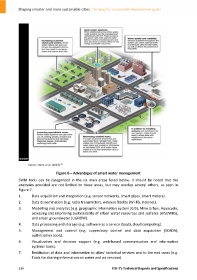Page 524 - Shaping smarter and more sustainable cities - Striving for sustainable development goals
P. 524
meter
24
Source: Berst et al. (2013).
Figure 6 – Advantages of smart water management
SWM tools can be categorized in the six main areas listed below. It should be noted that the
examples provided are not limited to these areas, but may overlap several others, as seen in
Figure 7.
1. Data acquisition and integration (e.g. sensor networks, smart pipes, smart meters).
2. Data dissemination (e.g. radio transmitters, wireless fidelity (Wi‐Fi), Internet).
3. Modelling and analytics (e.g. geographic information system (GIS), Mike Urban, Aquacycle,
assessing and improving sustainability of urban water resources and systems (AISUWRS),
and urban groundwater (UGROW).
4. Data processing and storage (e.g. software as a service (SaaS), cloud computing).
5. Management and control (e.g. supervisory control and data acquisition (SCADA),
optimization tools).
6. Visualization and decision support (e.g. web‐based communication and information
systems tools).
7. Restitution of data and information to cities’ technical services and to the end users (e.g.
Tools for sharing information on water and on services).
514 ITU‐T's Technical Reports and Specifications

